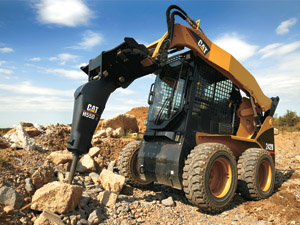
Tool Tips: Making the right connection
By David White
Features Tech tipsThere is much to know when it comes to matching the right work tool to multiple machines. Visibility, access, the type of coupler, hydraulic flow rates, tool configurations, hydraulic hose hook-ups and fittings should all be factored in when rental companies outfit their customers.
 |
| Hydro-mechanical work tools are powered by the machine’s auxiliary hydraulics. |
Connecting machines with the right work tool will maximize productivity
There is much to know when it comes to matching the right work tool to multiple machines. Visibility, access, the type of coupler, hydraulic flow rates, tool configurations, hydraulic hose hook-ups and fittings should all be factored in when rental companies outfit their customers. After identifying the customer’s needs, according to the job that needs to be required, there should be a couple of additional steps to consider before making a recommendation.
First, select a machine that allows easy exit and entry of the machine and offers good visibility from the operator’s seat to the work tool. Its coupler configuration should allow an operator unobstructed access to the seat and a clear view to the work tool. Second, determine the type of coupler the machine will need. The universal coupler interface and low profile side plates of mechanical quick couplers allow the most tools to match properly while keeping dirt and debris out. Two high-leverage handles serve to engage or disengage the tools.
Hydraulic quick couplers have a rocker switch in the cab that controls two hydraulic cylinders that replace the manual handles of a mechanical coupler, allowing the operator to change tools while in the cab. Hydraulic cylinders control the vertical wedge pins that lock the tool in place.
High flow and standard flow
Hydraulic power not only provides power to the wheels, but it also operates the loader to enable lifting and tilting, and runs the auxiliary circuit which drives work tools. The criteria for ‘high flow’ or ‘standard flow’ may differ from one manufacturer to another. Typically, high flow circuits exceed 26 gallons (98.5 litres) per minute and 3300psi. High flow machines designated ‘XPS’ – 33 gallons (125 litres) per minute at 4050psi – are capable of maintaining maximum pressure regardless of work tool speed or working conditions, at low or high idle. The typical flow for a standard-flow machine is 22 gallons (83 litres) per minute.
Types of tools
Work tools fall into two groups: fabricated and hydro-mechanical. Buckets and forks, which do not have moving parts controlled by the operator, are ‘fabricated’ tools. Hydro-mechanical work tools include multi-
purpose buckets, mulchers, hammers, augers, grapples, rakes and other attachments that are powered by the machine’s auxiliary hydraulics.
Fabricated work tools are the most universal and the machine from one manufacturer can attach the buckets or forks made by another manufacturer with very little trouble, as they do not require additional hydraulics to operate.
Hydro-mechanical work tools have more specific requirements. Therefore, most equipment manufacturers recommend machines use the hydro-mechanical work tools from the same manufacturer. Why? Hydraulic hose hook-ups and fittings are of the same strength and brand, ensuring a proper match and tight fit to reduce leaks and loss of pressure. Machines and work tools are designed to work as a system, and these pairings are intended to maximize the horsepower and hydraulic capabilities.
Work tools to match
Equipment manufacturers may offer a tool in a variety of configurations. Augers are a good example: Direct drive or planetary drive augers are available for standard hydraulic flow machines. These configurations are designed to maximize the capabilities of the hydraulic circuit and are intended for medium-duty applications. A high flow planetary-driven auger on a high flow hydraulic machine would be appropriate for extreme-duty applications. The high flow configuration is designed for maximum torque and the hydraulic hoses and seals are built to withstand the additional pressure and maintain a leak-free connection.
Additionally, some work tools are designed to accommodate or compensate for machines of a certain size. For instance, a landscape tiller model for machines up to 66 inches wide is offset to cover one set of the machine’s tire tracks.
Multiple machines
Choosing work tools that can be operated by multiple machines in your rental fleet will enhance their flexibility and the productivity of your customers on the job site. Two machines with similar hydraulic flow and horsepower, such as a large skidsteer loader and a small wheel loader, can usually run most of the same hydro-mechanical work tools. Generally, a machine with high flow hydraulics can operate work tools designed for standard flow machines, but the reverse pairing of high flow tools with a standard flow machine is not recommended. A standard flow machine’s hydraulic system will be unable to supply the flow needed to properly operate the tool.
Rental companies should advise contractors about a particular machine/work tool pairing to help them increase their job site efficiencies.
Print this page
Leave a Reply